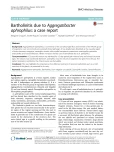-
Články
- Časopisy
- Kurzy
- Témy
- Kongresy
- Videa
- Podcasty
Bartholinitis due to Aggregatibacter aphrophilus: a case report
Background:
Aggregatibacter aphrophilus, a commensal of the oro-pharyngeal flora and member of the HACEK group of organisms, is an uncommonly encountered clinical pathogen. It has already been described as the causative agent of brain abscesses, empyema, meningitis, sinusitis, otitis media, bacteriemia, pneumonia, osteomyelitis, peritonitis, endocarditis and wound infections. Herein we report the first case of bartholinitis due to A. aphrophilus.Case presentation:
A 33-year-old woman was admitted for a 3-day genital pain without fever and urinary functional signs. The abscess was incised and drained; A. aphrophilus was the only micro-organism that grew from the pus. The patient received no antibiotics; the clinical course was favourable.Conclusion:
This case highlights the importance of an effective treatment of recurrent bartholinitis such as a cold resection of the gland. It is presented for its rarity.Keywords:
Aggregatibacter aphrophilus, Bartholinitis, Gram negative coccobacilli, Capnophilic bacteria, Genital infections
Autoři: Morgane Choquet 1; Emilie Pluquet 1; Sandrine Castelain 1,2*; Raphaël Guihéneuf 1,2; Véronique Decroix 1,2
Působiště autorů: Department of Bacteriology, Amiens University Hospital, Amiens, France 1; Microbiology Research Unit, EA4294, Jules Verne University of Picardie, Amiens, France 2
Vyšlo v časopise: BMC Infectious diseases 2016, 16:574
Kategorie: Case report
prolekare.web.journal.doi_sk: https://doi.org/10.1186/s12879-016-1908-1© 2016 The Author(s).
Open access
This article is distributed under the terms of the Creative Commons Attribution 4.0 International License (http://creativecommons.org/licenses/by/4.0/), which permits unrestricted use, distribution, and reproduction in any medium, provided you give appropriate credit to the original author(s) and the source, provide a link to the Creative Commons license, and indicate if changes were made. The Creative Commons Public Domain Dedication waiver (http://creativecommons.org/publicdomain/zero/1.0/) applies to the data made available in this article, unless otherwise stated.
The electronic version of this article is the complete one and can be found online at: http://bmcinfectdis.biomedcentral.com/articles/10.1186/s12879-016-1908-1Souhrn
Background:
Aggregatibacter aphrophilus, a commensal of the oro-pharyngeal flora and member of the HACEK group of organisms, is an uncommonly encountered clinical pathogen. It has already been described as the causative agent of brain abscesses, empyema, meningitis, sinusitis, otitis media, bacteriemia, pneumonia, osteomyelitis, peritonitis, endocarditis and wound infections. Herein we report the first case of bartholinitis due to A. aphrophilus.Case presentation:
A 33-year-old woman was admitted for a 3-day genital pain without fever and urinary functional signs. The abscess was incised and drained; A. aphrophilus was the only micro-organism that grew from the pus. The patient received no antibiotics; the clinical course was favourable.Conclusion:
This case highlights the importance of an effective treatment of recurrent bartholinitis such as a cold resection of the gland. It is presented for its rarity.Keywords:
Aggregatibacter aphrophilus, Bartholinitis, Gram negative coccobacilli, Capnophilic bacteria, Genital infections
Zdroje
1. Maraki S, Papadakis IS, Chronakis E, et al. Aggregatibacter aphrophilus brain abscess secondary to primary tooth extraction: Case report and literature review. J Microbiol Immunol Infect. 2013. doi:10.1016/j.jmii.12.007.
2. Patel SR, Patel NH, Borah A, et al. Aggregatibacter aphrophilus pacemaker endocarditis: a case report. BMC Res Notes. 2014;7 : 885.
3. Sing A, Roggenkamp A, Kress K, et al. Bartholinitis Due to Streptococcus pneumoniae: Case Report and Review. Clin Infect Dis. 1998;27(5):1324–5.
4. Bleker OP, Smalbraak DJ, Schutte MF. Bartholin’s abscess: the role of Chlamydia trachomatis. Genitourin Med. 1990;66(1):24–5.
5. Kessous R, Aricha-Tamir B, Sheizaf B, et al. Clinical and microbiological characteristics of Bartholin gland abscesses. Obstet Gynecol. 2013;122(4):794–9.
6. Teranishi H, Ohzono N, Inamura N, et al. Detection of bacteria and fungi in blood of patients with febrile neutropenia by real-time PCR with universal primers and probes. J Infect Chemother. 2015;21(3):189–93.
7. Khairat O. Endocarditis due to a new species of Haemophilus. J Pathol Bacteriol. 1940;50 : 497–505.
8. Quentin R, Pierre F, Dubois M, et al. Frequent isolation of capnophilic bacteria in aspirate from Bartholin’s gland abscesses and cysts. Eur J Clin Microbiol Infect Dis. 1990;9(2):138–41.
9. Roberts DB, Hester LL. Progressive synergistic bacterial gangrene arising from abscesses of the vulva and Bartholin’s gland duct. Am J Obstet Gynecol. 1972;114 : 285–91.
10. Horowitz IR, Buscema J., Woodruff JD. Surgical conditions of the vulva, in Rock JA, Thompson JD (eds): The Linde's Operative Gynecology. 8th ed. Philadelphia, Lippincott-Raven, 1997; pp 890-893.
11. Parvathi S, Imara A, Thoduka T. Bartholinitis caused by Streptococcus pneumoniae: Case report and review of literature. Indian J Pathol Microbiol. 2009;52(2):265.
12. Berger SA, Gorea A, Peyser MR, et al. Bartholin’s gland abscess caused by Neisseria sicca. J Clin Microbiol. 1988;26(8):1589.
Štítky
Infekčné lekárstvo
Článok vyšiel v časopiseBMC Infectious diseases
Najčítanejšie tento týždeň
2016 Číslo 574- Očkování proti virové hemoragické horečce Ebola experimentální vakcínou rVSVDG-ZEBOV-GP
- Koronavirus hýbe světem: Víte jak se chránit a jak postupovat v případě podezření?
Najčítanejšie v tomto čísle
Prihlásenie#ADS_BOTTOM_SCRIPTS#Zabudnuté hesloZadajte e-mailovú adresu, s ktorou ste vytvárali účet. Budú Vám na ňu zasielané informácie k nastaveniu nového hesla.
- Časopisy



